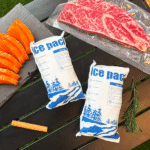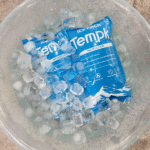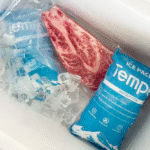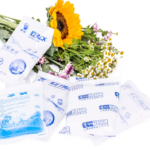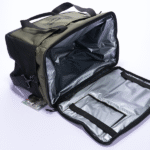How Pharma Cold Chain Technology Is Evolving in 2025
Actualizado en noviembre 24 2025 - Pharma cold chain technology underpins the safe delivery of vaccines, biologics and advanced cell therapies. En 2025 the market grew to over US$10 billion y se prevé que alcance US$18.2 billion by 2030. Este artículo explora las últimas innovaciones., compliance requirements and practical strategies you can use to strengthen your cold chain operations. You’ll discover how blockchain-enabled tracking, Monitoreo de IoT y embalaje sostenible are transforming the way pharmaceutical products are stored and transported. Whether you manage a warehouse or oversee regulatory compliance, you will find actionable insights to reduce risk and protect product integrity.

What makes pharma cold chain technology critical in 2025? Understand why biologics, mRNA vaccines and precision therapies demand stringent temperature control.
¿Cómo son las IoT?, blockchain and AI shaping cold chain logistics? Explore cutting-edge technologies that deliver real time visibility and predictive analytics.
Which packaging innovations ensure drug safety and sustainability? Learn about advanced passive packaging, vacuum insulated panels and reusable shippers.
How do you comply with 2025 regulaciones? Discover DSCSA deadlines, Buena práctica de distribución (PIB) standards and ALCOA+ data integrity principles.
What trends will dominate the market by 2030? See how market growth, regional dynamics and sustainability initiatives will shape the future.
Why Does Pharma Cold Chain Technology Matter in 2025?
Temperature-sensitive drugs are more prevalent than ever. Encima 40 % of new drugs approved in 2024 were biologics, and many require storage at –20 °C a –80 °C. Vacunas, monoclonal antibodies and gene therapies degrade rapidly if exposed to heat. Studies estimate that about 20 % of temperature-sensitive healthcare products are damaged during distribution, con 30 % of shipments experiencing temperature excursions. Such failures lead to financial losses, regulatory penalties and patient harm.
Growing demand for biologics and mRNA vaccines is expanding the cold chain. The global cold-chain pharma market grew from Dólar estadounidense 8.85 mil millones en 2024 a USD 10.04 mil millones en 2025 y se prevé que alcance Dólar estadounidense 18.20 mil millones por 2030 con un 12.7 % Tocón. Rising investments in cell and gene therapy research mean more products require temperaturas ultra bajas—sometimes down to –150°C. Government vaccination programs and personalized medicines are also increasing demand in Asia Pacific.
Impact of Cold Chain Failures
| Failure Type | Consecuencia | Por qué te importa |
| Temperature Excursion | Degradación del producto, recall, financial loss | Breaks the chain of custody and damages patient trust. |
| Data Integrity Lapses | Regulatory sanctions for incomplete audit trails | Compliance is mandatory; data must be Attributable, Legible, Contemporaneous, Original and Accurate (ALCOA+). |
| Packaging Failures | Physical damage and exposure during transit | Insufficient insulation or gel packs lead to compromised batches. |
| Cortes de energía | Unplanned warming and product spoilage | Ultra-cold units require redundant power and backup systems. |
Consejos y consejos prácticos
Identify Critical Therapies: Catalogue which biologics, vaccines or gene therapies must stay between 2–8 °C, –20 °C or even cryogenic conditions.
Assess Failure Points: Analyze previous excursions and map where temperature deviations occurred—production, transport or last-mile delivery.
Budget for Redundancy: Invest in backup generators and dual refrigeration units to avoid losses during power failures.
Educate Your Team: Human error contributes to many cold-chain failures. Train staff on handling protocols, temperature checks and chain-of-custody documentation.
Caso del mundo real: Durante el lanzamiento de la vacuna COVID 19, logistics providers like UPS Healthcare developed insulated containers with real time sensors to maintain required temperatures. These validated boxes ensured vaccines remained viable throughout transport, demonstrating how technology and processes can work together to protect product quality.
How Do IoT, Blockchain and AI Transform Cold Chain Logistics?
Real time visibility is now a necessity. Internet de las cosas (IoT) sensors continuously measure temperature, humedad y ubicación, transmitting data to operators via text or mobile apps. Cuando los sensores detectan temperaturas inseguras, they send alerts so corrective actions can be taken immediately. IoT-enabled smart packaging also tracks shock, tilt and light exposure to ensure shipments are handled correctly.
Blockchain creates a tamper proof record of every shipment. Each transaction—from manufacturing to delivery—is stored in a secure distributed ledger, preventing data manipulation. Real-time data logs on temperature and humidity can be shared with all stakeholders, enhancing transparency and regulatory compliance. Blockchain also helps verify product authenticity and prevents counterfeiting.
Inteligencia artificial (AI) optimizes routes and predicts risks. AI-driven route planning adjusts deliveries based on traffic and weather, Reducir el consumo de combustible y los retrasos.. Predictive analytics use historical and real time sensor data to forecast temperature excursions before they happen. Combined with IoT, AI systems provide early warnings and automatically recommend corrective actions.
Deep Dive: Smart Storage and Monitoring
Modern cold storage facilities are getting colder and smarter. Ultra cold rooms maintain multiple temperature zones—2–8 °C, –20 ºC, –80 °C and even cryogenic conditions. IoT-connected storage units offer real-time dashboards and excursion alerts. Automated systems control access, maintain redundancy and log every interaction. Smart packaging logs temperature history from manufacturing through patient delivery.
| Tecnología inteligente | Key Function | Beneficiarte para ti |
| Sensores IoT | Real-time monitoring of temperature, humedad y ubicación | Enables immediate corrective action and reduces excursion risk. |
| Blockchain Platforms | Immutable record of product journey | Mejora la trazabilidad, prevents counterfeiting and simplifies audits. |
| AI Route Optimization | Predicts optimal delivery routes based on traffic and weather | Reduces fuel costs, emissions and delays, while maintaining temperature. |
| Análisis predictivo | Uses historical and real-time data to forecast issues | Anticipates excursions and schedules maintenance proactively. |
| IoT-Enabled Packaging | Logs environmental data throughout shipment | Provides complete temperature history for compliance and continuous improvement. |
Consejos y consejos prácticos
Invest in IoT Devices: Start with sensors that monitor temperature and location in real time. Look for models that integrate with your existing systems.
Implement Blockchain Incrementally: Begin with pilot programs tracking high value shipments; expand as your team gains experience.
Use AI for Route Planning: Utilize AI software that accesses traffic, weather and infrastructure data to optimize deliveries.
Develop Response Protocols: Define who receives alerts, how to react and when to quarantine shipments to minimize losses.
Caso real: The Nordic Express Pack launched in July 2025 includes irreversible temperature indicators and compact design tailored for GLP 1 medications. Coupled with AI-based logistics, this pack reduces freight costs and ensures compliance.
Which Packaging Innovations Ensure Drug Safety and Sustainability?
Packaging is the frontline defense against temperature excursions. En 2024 the pharmaceutical cold chain packaging market was worth roughly Dólar estadounidense 17.93 mil millones y se espera que alcance Dólar estadounidense 63.30 mil millones por 2033. Passive packaging—that is, insulation and phase change materials requiring no active refrigeration—holds about 72.5 % cuota de mercado because it is reliable and cost effective. North America currently holds more than 36 % de cuota de mercado due to its mature biopharma industry and strict regulations.
Materials and Formats
Plastic shippers: Plastic dominates with encima 74 % cuota de mercado due to durability and insulation. Reusable plastic containers reduce waste and provide long service life.
Papel & paperboard: This eco friendly segment is growing at ≈16.4 % Tocón. Laminated paperboards and fibre-based materials improve insulation while reducing landfill impact.
Metal containers: Used for high performance requirements; they offer robust structural support but are heavier and more expensive.
Packaging formats: Small boxes (capturing >42 % compartir) are ideal for vaccines and personalized medicine. Pallets support bulk shipments and show the fastest growth (~15.9 % Tocón). Large containers provide extended thermal protection for intercontinental shipments.
On the Ground Recommendations
Define Temperature Requirements: For mRNA vaccines or gene therapies, choose packaging with ultra low capabilities and validated phase change materials.
Plan for Transit Duration: Small insulated boxes suit local deliveries; long-distance shipments require palletized containers with extra insulation.
Adopt IoT Monitoring: Real-time temperature and location tracking reduces excursion risk and supports compliance.
Prioritize Sustainability: Reusable shippers and recyclable materials align with environmental goals.
| Packaging Format | Typical Use Case | Ventajas | Contras | Lo que significa para ti |
| Small boxes | Vacunas, biológicos, medicina personalizada | Lightweight and cost-effective; ideal for last mile delivery | Limited volume; careful handling needed | Perfect for clinics and pharmacies delivering local treatments. |
| Pallets | Bulk shipments of APIs or vaccine batches | Efficient loading/unloading; supports long-distance transport | Mayor costo inicial; requires specialized equipment | Best for manufacturers shipping large volumes globally. |
| Large containers | International shipments or clinical trials | Extended thermal protection; supports multimodal transport | Heavy and expensive; complex logistics | Use for cross-continental trials or high-volume exports. |
Sustainability and New Technologies
Contenedores reutilizables: Companies like Pelican BioThermal and Sonoco ThermoSafe offer reusable shippers with integrated data loggers. These reduce long-term costs and support corporate ESG goals.
Materiales biodegradables: Nordic Cold Chain designs biodegradable packaging that balances thermal performance with environmental responsibility.
Advanced phase change materials (PCM): New PCMs maintain ultra low temperatures without dry ice, reducing hazard risk.
AI-driven packaging design: AI tools analyze product profiles to select optimal insulation and refrigerants, mejorar la eficiencia y reducir el desperdicio.
Caso real: Insulin pens are often shipped in small insulated boxes with gel packs, maintaining 2–8 °C during last-mile delivery. This simple approach ensures diabetic patients receive potent medication.
How Do You Comply With 2025 Regulaciones?
Los marcos regulatorios se están endureciendo, and compliance is mandatory. Los EE. UU.. Ley de seguridad de la cadena de suministro de medicamentos (DSCSA) mandates interoperable electronic tracking by 27 Noviembre 2025 for dispensers with more than 25 pharmacists. Large distributors face additional deadlines in May and August 2025. El Ley de modernización de la seguridad alimentaria (FSMA) emphasizes preventive controls and supply chain traceability. En Europa, Buena práctica de distribución (PIB) Pautas y Anexo GMP de la UE 1 require validated equipment, environmental monitoring and data integrity. El World Health Organization’s Model Guidance y ISO 14644 3 provide international benchmarks for thermal mapping and cleanroom testing.
Requisitos regulatorios clave
Mantenimiento de temperatura: Products must remain within validated ranges (typically 2–8 °C, –20 °C or –70 °C for biologics).
Electronic tracking: DSCSA requires interoperable traceability systems; blockchain and serialized barcodes fulfil this requirement.
Data integrity: Records must comply with ALCOA+ principles—Attributable, Legible, Contemporaneous, Original and Accurate. Electronic systems need secure audit trails and validated e signatures (21 Parte CFR 11).
Qualification phases: Design Qualification (DQ), Installation Qualification (IQ), Operational Qualification (OQ) and Performance Qualification (PQ) ensure packaging, equipment and processes meet standards.
Mapeo de temperatura: Sensors are placed throughout storage areas to identify hot and cold spots. Mapping should be performed before use, after major changes and periodically—often twice a year.
Consejos de cumplimiento
Deploy environmental monitoring systems (EMS): Integrate sensors with software that stores, visualizes and analyzes data in real time.
Plan for regulatory audits: Maintain documentation on mapping studies, calibration certificates and standard operating procedures (Sops).
Stay ahead of DSCSA deadlines: Start implementing electronic product code (EPCIS) systems early and test integrations with trading partners.
Collaborate with third-party logistics providers (3PL): Experienced providers often have certified systems and can help you navigate regional variations.
Caso del mundo real: The DSCSA compliance schedule means that dispensers with more than 25 pharmacists must implement interoperable tracking by Noviembre 27 2025. Early adoption of blockchain-enabled tracking platforms ensures your organization can meet this deadline without disruption.
What Are the Biggest Challenges and How Do You Overcome Them?
Temperature control is the foremost challenge. Extended transit times, extreme weather and varied handling practices across regions increase the risk of excursions. Insulated shipping containers and gel packs engineered to maintain internal temperatures mitigate this risk. Ultra cold storage requires redundant power systems and backup generators.
Regulatory compliance is complex. The patchwork of regulations across countries necessitates robust documentation and processes. Working with 3PLs that customize solutions to meet regional requirements simplifies compliance.
Packaging fragile products without waste: Biologics and delicate medications require robust protection against shock and vibration while maintaining temperature. Advanced materials and sustainable packaging can achieve both.
Data management and security: With increasing reliance on IoT and blockchain, ensuring cyber security and data integrity is paramount.
Solutions and Best Practices
Use qualified insulated containers and gel packs: Choose packages that have undergone design testing and performance validation for your temperature profile.
Implement real time tracking and alerts: GPS and temperature loggers enable quick responses to deviations.
Mapee su cadena de suministro: Conduct a thorough cold-chain mapping to identify vulnerabilities before shipping.
Invest in employee training: Educate staff on SOPs, regulatory requirements and emergency responses.
Partner with experienced logistics providers: Use specialized 3PLs to handle multi-regional compliance and provide advanced monitoring systems.
Incorporate sustainable practices: Adoptar contenedores reutilizables, bio-based insulation and route optimization to minimize carbon footprint.
Caso real: To address temperature excursions, Nordic Cold Chain developed insulated containers paired with gel packs that regulate internal temperature during extended transit. By integrating advanced temperature monitoring, their solution reduces risk and ensures regulatory compliance.
2025 Market Developments and Future Trends
Descripción general de la tendencia
The pharmaceutical cold chain market is evolving rapidly. Key developments driving the sector in 2025 incluir:
Blockchain-enabled tracking platforms: Real-time visibility and immutable records are improving compliance and reducing fraud.
IoT-enabled smart packaging: Sensors monitor critical temperature deviations in real time.
Scaling ultra-low temperature infrastructure: Increased investment in –20 °C, –40 °C and –80 °C storage to support mRNA vaccines at global scale.
Eco-friendly thermal insulation: Adoption of biodegradable materials and energy efficient packaging to reduce environmental impact.
Strategic partnerships and 3PL collaboration: Biopharma companies are partnering with specialized logistics providers for last-mile deliveries.
Armonización regulatoria: Efforts to streamline cross-border logistics and reduce compliance delays.
Latest Developments Snapshot
Nordic Express Pack Launch (Julio 2025): Nordic Cold Chain Solutions introduced a compact package for GLP 1 medications, featuring irreversible temperature indicators and improved freight efficiency.
mRNA and Cell Therapies Expansion: The rise of personalized medicine requires packaging capable of maintaining ultra-low temperatures and providing real-time monitoring.
Logística impulsada por IA: Automated route planning and predictive analytics optimize scheduling, reduce energy consumption and enhance compliance.
Southeast Asia Innovations: Solar-powered cold storage units reduce energy costs and provide sustainable solutions in regions with inconsistent power supply. Portable cryogenic freezers maintain temperatures as low as –150 °C for biologics and cell therapies.
Market Insights and Regional Dynamics
The global pharmaceutical cold chain market is expected to exceed US$10 billion in 2025 y alcanzar US$18.2 billion by 2030. North America holds over 36 % of the packaging market, thanks to a strong biopharma industry and stringent FDA requirements. Europe follows with strict EMA regulations and a robust clinical trial environment. Asia Pacific is the fastest growing region, projected to expand at around 6 % Tocón due to expanding generic drug manufacturing and government vaccination programs. Emerging markets still face infrastructure challenges like unreliable power supply and limited cold storage.
Business Strategies for 2025 y más allá
Diversify transportation modes: Utilize multimodal transport (aire, carril, camino, mar) to mitigate risk and optimize cost.
Collaborate across sectors: Deepen collaboration between packaging manufacturers, logistics providers and tech firms for integrated solutions.
Adopte la sostenibilidad: Adopt bio-based insulating materials and energy-efficient refrigeration to align with corporate ESG goals.
Invest in analytics: Predictive analytics and cloud-based platforms drive operational efficiency and risk management.
Prepare for tariffs and geopolitical shifts: New US tariffs on imported packaging materials are reshaping procurement strategies. Local sourcing and modular container design can mitigate financial and operational exposure.
Preguntas frecuentes (Preguntas frecuentes)
What is the 2–8 °C cold chain?
The 2–8 °C range is the optimal temperature for storing and transporting many pharmaceuticals, incluyendo vacunas y productos biológicos. Keeping products within this range preserves potency and safety.
Why are temperature excursions problematic?
Even brief deviations from the recommended range can degrade a drug’s efficacy or render it unsafe. Real-time monitoring helps prevent excursions and protects patient health.
What technologies improve cold chain logistics?
sensores de iot, blockchain records, AI route optimization and automated warehouses all enhance visibility, eficiencia y cumplimiento.
How does IoT benefit pharmaceutical cold chains?
IoT devices track temperature, humedad y ubicación, sending immediate alerts when conditions change. This enables quick corrective actions and reduces product loss.
What does ALCOA+ mean?
ALCOA+ stands for Attributable, Legible, Contemporaneous, Original and Accurate. It outlines data integrity requirements for electronic records.
Resumen y recomendaciones
Control de llave: The pharmaceutical cold chain market is expanding rapidly, driven by biologics and mRNA vaccines. Temperature excursions and data integrity remain critical risks; 20 % of temperature-sensitive products are damaged during distribution. IoT, blockchain and AI provide real time visibility and predictive capabilities, mientras advanced passive packaging ensures thermal stability. Regulations are tightening with DSCSA deadlines in 2025, and compliance requires robust tracking and documentation. Sustainable materials and reusable shippers are gaining traction, and strategic partnerships help companies navigate global logistics.
Plan de acción:
Assess Your Supply Chain: Identify products requiring cold chain and map your entire distribution network.
Implementar monitoreo de IoT: Deploy sensors and real time dashboards to detect excursions immediately.
Adopt Blockchain Tracking: Pilot blockchain for high-value shipments to meet DSCSA requirements.
Invest in Advanced Packaging: Choose reusable containers and sustainable materials tailored to your temperature profile.
Strengthen Compliance: Realizar mapeo de temperatura, maintain documentation and stay ahead of regulatory deadlines.
Asóciese con expertos: Collaborate with specialized 3PLs and technology providers to scale operations and meet regional requirements.
Acerca de Tempk
Templ is a leading innovator in cold chain packaging and logistics solutions. Nuestra R&D team develops eco-friendly insulated boxes, paquetes de gel y validated packaging for temperatures from 0–10 °C and below. With Sedex certification and a commitment to quality, we partner with pharmaceutical companies worldwide to ensure safe delivery of vaccines, biologics and personalized therapies. Our solutions include reusable bolsas de hielo, bolsas aisladas, transportistas de paletas y smart monitoring technology, all designed to protect product integrity while minimizing environmental impact.
Siguientes pasos: To find the right cold chain solution for your needs, consult our specialists. We’ll help you implement advanced packaging, real time monitoring and compliance strategies tailored to your operations.

















